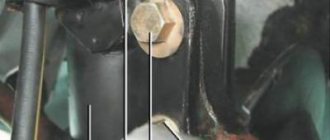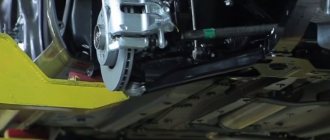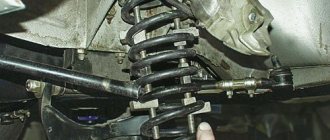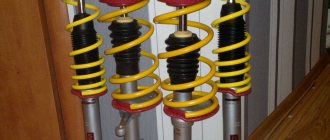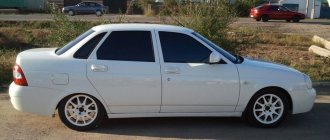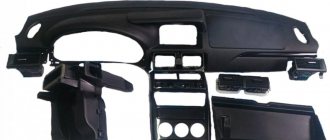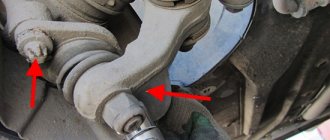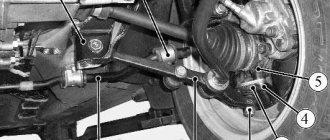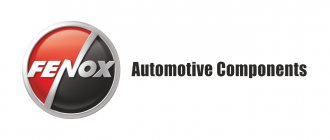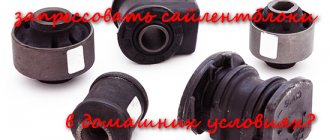Print this article Font size 16
Every motorist understands how important the front suspension of the VAZ 2110 plays. But this unit may have certain problems, characteristic malfunctions, which almost everyone who has more or less little experience in car repair can know and fix. Therefore, today we will talk specifically about the front suspension of the “tens”.
What does the VAZ suspension consist of?
1 — transverse arm mounting bracket, 2 — stabilizer bar cushion, 3 — bar cushion bracket, 4 — stabilizer bar, 5 — transverse arm, 6 — stabilizer strut, 7 — ball joint, 8 — steering knuckle, 9 — telescopic strut, 10 — transverse arm extension, 11 — front mounting bracket for the transverse arm extension, 12 — cross member.
What should you pay attention to?
If you hear a knock in the front suspension while driving, the main reasons may be:
- — Malfunctions in the rack;
- — The bolts have become loose, the stretch marks or cushions with which the cross member is equipped may have worn out;
- — The attachment to the body is loose;
- — The rubber parts have collapsed, and the knocking has a distinct “metallic” sound;
- — A “limp” or even a broken spring knocks;
- — Wear of hinges;
- — Knocking due to wheel imbalance;
- — Settlement or breakage of the suspension spring;
The car pulls to the side when driving straight. The reasons for this malfunction may include:
- — Each spring has its own compression ratio. In this case, the spring that has lost its elasticity must be replaced;
- — Tires have different pressures. We check and correct;
- — The rubber element near one of the strut supports was destroyed. At the same time, a characteristic knocking sound is also heard while driving. The problem is solved by replacing this element;
- — The wheel alignment angles are incorrect. Increased tire wear may be associated with this malfunction.
Tire wear. This may be due to improper driving (rash acceleration, braking, exceeding the permissible load of the vehicle), or other reasons:
- — violations of wheel alignment angles;
- — high wear of the hinges;
- — wheel imbalance;
When driving with increasing speed, metallic noise increases:
- — Check the wheel bearings;
- — When starting to move, a characteristic “crunch” appears;
- — Inspect the CV joints, such a sound can only be made by balls that roll along the grooves, because have too much output.
Knowing the meaning and design of the suspension, you can check its condition every time you inspect the machine on a pit (overpass) and perform maintenance. Pay special attention to the condition of the protective covers on the ball joints. Check to see if any deformations, cracks or dents have appeared on the suspension due to shaking and bumps. You should also check the tightness of all nuts.
Be sure to check the condition of all rubber and rubber-to-metal parts, as well as the ball joint of each wheel. We must remember: a malfunction noticed and corrected in time is much less evil than repairs when everything is already falling apart.
↑ Design description
Front suspension
– independent with telescopic hydraulic shock absorbers, helical coil springs, lower wishbones with braces and a stabilizer bar. The basis of the suspension is a telescopic hydraulic shock absorber strut 16. Its lower part is connected to the steering knuckle 19 with two bolts. The upper bolt 18, passing through the hole in the rack bracket, has an eccentric collar and an eccentric washer. By turning this bolt, the camber of the front wheel is adjusted. The telescopic strut is equipped with: a coil spring 7, a polyurethane foam compression stroke buffer 9, as well as an upper strut support 12 assembled with a bearing 11.
Main nodes
Let's talk about its device. The most important element of the front suspension is its strut (hydraulic telescopic) - indispensable in the matter of shock absorption, that is, ensuring a comfortable ride, without much shaking (as far as possible) over bumps and potholes on our roads. It is thanks to the rack, or rather its steering knuckle with an upper bolt equipped with an eccentric washer and a belt, that makes it possible to change the camber of the wheel.
Telescopic strut of the front suspension of VAZ 2110
The following are installed on the rack:
- Special spring;
- Buffer limiting the compression stroke, made of polyurethane;
- Upper support. Its structure is as follows: it is attached to a stand, to which the mudguard is attached with self-locking nuts. Therefore, if you make repairs yourself, do not miss this moment - you cannot use ordinary nuts;
- A bearing that makes it possible to rotate the stand together with the wheels;
- A shock absorber in which a spring and a plunger are installed for better performance.
The ball joint combines the lower parts: the steering knuckle and the lever. The longitudinal braces, lower arms, and supports that the crossbar has are connected to each other by rubber-metal hinges. With the help of special washers, it becomes possible to adjust the longitudinal inclination of the turning axis. An angular contact, non-adjustable bearing secures the wheel hubs.
Ball joint VAZ 2110
The cross member is the rod to which the lower arms are connected. It is attached to the body in the middle, helped by rubber cushions.
This, in a nutshell, is the front suspension design. Now let’s look at possible malfunctions, which in some cases can be fixed with your own hands, in others it is better to contact specialists.
Cross member VAZ 2110
Purpose
The wheels are attached to the front suspension; the unit provides shock absorption for the “front” of the car, is responsible for stability while driving, wheel adjustment, camber, and toe-in.
The front suspension design of the VAZ 2110 is quite complex, but any of you can figure it out. The main thing here is to arm yourself with an instruction manual, as well as understand the essence of the main angles.
Possible breakdowns
Knock
If you hear a knock in the front suspension while driving, the main reasons may be:
- Faults in the rack;
- The bolts have become loose, the stretch marks or cushions with which the cross member is equipped may have worn out;
- The attachment to the body has become loose;
- The rubber parts have collapsed, and the knocking has a distinct “metallic” sound;
- A “limp” or even a broken spring knocks;
- Wear of hinges;
- Knocking due to wheel imbalance.
In principle, in any of the listed cases, repairing the VAZ 2110 front suspension, done by yourself, can help, during which you need to replace a worn part or (in the latter case, the reasons why a knock is heard) - balance the wheel.
Vehicle pull to the side
The car pulls to the side when driving straight. The reasons for this malfunction may include:
- Each spring has its own compression ratio. In this case, the spring that has lost its elasticity must be replaced;
- Tires have different pressures. We check and correct;
- The rubber element near one of the strut supports was destroyed. At the same time, a characteristic knocking sound is also heard while driving. The problem is solved by replacing this element;
- The wheel alignment angles are incorrect. Increased tire wear may be associated with this malfunction. If you can’t handle it yourself, it’s better to entrust this task to specialists.
Typical faults
The front suspension is characterized by certain breakdowns, which are determined by two phenomena:
They should be considered separately, since the reasons for their appearance are different.
Knocks
If you start to hear knocking noises coming from the front suspension, this could be caused by several reasons:
- The rack has certain faults;
- The ties on the cross member, the cushions are worn out or the bolts are loose;
- The attachment to the body was not strong enough;
- The springs have failed;
- The hinges are worn out;
- The rubber part of the suspension has broken its integrity. The knock should be clear, like the impact of metal on metal;
- Wheel alignment is out of balance.
If you do not hear a knock, but a noise, then the causes of front suspension problems may be as follows:
- The bolts that secure the stabilizer bar to the body have become loose;
- The rubber components in the strut support have collapsed;
- The rubber pads of the coupler or rod are worn out;
- The suspension spring has broken or violated its geometry;
- The wheels are unbalanced;
- The compression stroke buffer has collapsed.
Increased tire wear
If you are not a fan of fast acceleration, harsh braking, or do not overload the car, then the reasons for increased wear may be:
- The wheel alignment angles are incorrect;
- The hinges are worn out;
- Wheel balance is off.
Suspension check
Knowing the meaning and design of the suspension, you will be able to check its condition every time you inspect the machine on a pit (overpass) and perform maintenance. Pay special attention to the condition of the protective covers on the ball joints. Check to see if any deformations, cracks or dents have appeared on the suspension due to shaking and bumps.
Be sure to check the condition of all rubber and rubber-to-metal parts, as well as the ball joint of each wheel. Remember: a malfunction noticed and corrected in time is much less evil than repairs when everything is already falling apart.
Replacing a broken spring
To replace the spring (which also cannot be repaired), you need to remove the shock absorber and disconnect it from the roll bar. After this, you need to loosen the screws of the lower arm, after that it is jacked up, then using a special puller we remove the ball pin.
Now you can slowly release the jack, as a result of which the spring weakens and is easily removed from the cup.
Attention! A new spring can be placed in the support bowl only by first tightening it with a special tie. After this, the lower arm is pressed in the same way, then its ball joint enters the steering knuckle
Then you can release the spring from the tie. Shown is a diagram of spring compression using a tie
After this, the lower arm is pressed in the same way, then its ball joint fits into the steering knuckle. Then you can release the spring from the tie. A diagram of spring compression using a tie is shown.
In conclusion, it must be said that a novice motorist is quite capable of monitoring the serviceability of the suspension, the main thing is that he has an overpass or a pit at his disposal.
The suspension of any car consists of many different parts that have different functions. One of these parts is a ball joint, which is a connecting part that allows the front wheels to rotate in different directions. If a part malfunctions, serious consequences can arise, so we will figure out how to check the ball joint of a VAZ 2107, and what may be needed for this.
conclusions
Of course, suspension repair work is quite complex and labor-intensive.
This is not easy to do without a special tool. But domestic motorists often make do with even a standard set of keys, which is available in every garage. The strut spring is compressed using a wire, and the ball pin is knocked out using various available devices. A VAZ is not a foreign car, so the car tolerates such treatment.
Didn't find the information you are looking for? on our
forum
.
If you find an error, please highlight a piece of text and press Ctrl Enter.
CV joints
Most often, a faulty CV joint manifests itself as a distinct crunching sound when the steering wheel is turned in any direction when driving hard. When this symptom is observed in a car, it makes sense to drive the car into a pit and check it.
In order to check the CV joint yourself, you first need to perform a visual inspection; if the boots are torn, there is a high probability that the CV joint is faulty, since the dirt that will fly under it will act as an abrasive and will accelerate wear several times.
Next, check for play. To do this, grab the drive and pull it clockwise and counterclockwise; if you feel play, it means the CV joint is faulty.
The above is not all that is included in the diagnosis. These procedures will only help determine the general condition of the main suspension components. For a more in-depth analysis of the wear of a particular element, equipment that is only available at a service station may be required.
Wheel bearings
If the hub bearings are faulty, they produce a hum that appears when driving. This hum becomes very audible when driving on a flat road at one speed.
To be sure that it is the hub bearing and not some gearbox bearing, you need to accelerate the car a little, turn off the gear so that the car coasts. If our fears were confirmed.
To find out which bearing is humming, you need to jack up the car and spin the wheel; if you feel the characteristic grinding noise of the bearing, it means the bearing is faulty.
When the situation is very advanced, the wheel appears to have play in the vertical plane. The more the bearing is worn, the greater the play will be.
Steering rack
The steering rack very often begins to knock when driving at high speed on bad roads. A knocking sound from the steering rack indicates that it needs to be repaired as quickly as possible. If this is not done, then in the future you may end up having to replace the steering rack, and this is very expensive.
The steering rack often begins to knock on cars that have a very stiff and compressed suspension. It does not absorb the full force of the impact, and part of the impact falls on the steering rack. Special crackers are installed in the steering rack, which are needed to prevent the shaft from playing. Over time, these crackers wear out, and constant impacts that the suspension does not dampen accelerate this process. The rack begins to knock. The knock is very similar to the knock of the stabilizer struts.
To check the rack, you need to climb into the hole, or remove the wheels, and pull the rack shaft, first on one side and then on the other. If beating is felt, the rack needs to be repaired.
It will also be useful to know that one of the characteristic signs of this malfunction is a kickback in the steering wheel when driving over uneven surfaces.
Ball
In order to make the suspension diagnostics more complete, it is necessary to check the ball joints. A ball joint is an element that connects a movable hub and a fixed suspension arm. Ball joints often fail due to fast driving on bad roads.
If there is wear on the balls, a dull sound will be heard. It will be especially obvious when driving over uneven surfaces.
You can accurately diagnose ball joints using two methods:
- Side to side rocking method. To do this, you will need an assistant who will check for knocking in the wheel area during rocking. If it is, do not rush to judge the ball joints, check using the second method.
- To implement the second method, it is necessary to jack up the car, observing safety methods. To eliminate the possibility of bearing play, you need someone to press the brake pedal. At this moment, you need to rock the wheel by holding the top and bottom points (as on the 12 and 6 o’clock dial). If you feel noticeable play, then the support needs to be changed.
Replacement of front struts of VAZ 2110, 2111 and 2112
| The front struts of the VAZ 2110 are designed to absorb shocks and impacts on the car body. Their approximate service life is 60-100 thousand km. mileage, and it largely depends on operating conditions. If you notice that the car has become less stable on the road, replacing the shock absorbers will most likely solve the problem. |
Tie rods and ends
The symptoms of faulty tie rod ends can be compared to the symptoms of a faulty steering rack, namely a knocking sound when driving over uneven surfaces.
In order to accurately diagnose the malfunction of these elements, you need to visually inspect the rubber parts; if they are cracked or torn, then there is a high probability that these parts are faulty.
You can check these elements for play by using a mount by rocking it up and down. If you feel noticeable play, then most likely the ball joints of the steering rods or ends are worn out.
Analogs
In addition to domestic parts, you can install front struts from other manufacturers, which will cost much more:
- Sachs;
- Monroe;
- Brillstein;
- Kayaba;
- KONI.
Although installing expensive parts on domestic cars is not always economically justified, some people prefer to spend a large sum once, but then do not have to worry about replacement for several years.
Aston racks are another analogue of domestic production.
Shock absorbers
Shock absorbers of telescopic struts play a very important role in a car - they dampen body vibrations and are responsible for the stability of the car on the road when performing maneuvers.
It is quite easy to check the performance of shock absorbers. To do this, pick up and rock the car when it is standing on a flat surface. After you stop trying to rock the car, it should stop. If the rear shock absorbers or front ones are faulty, it will continue to sway.
If the shock absorbers are faulty, operating the car becomes problematic. The car feels unassembled and there are breakdowns on some uneven surfaces.
You definitely need to drive the car into a pit or overpass and see if there are any leaks on the shock absorbers - if there are any, then the shock absorber is not in order and should be replaced.
For a deeper analysis of worn parts, you need a special vibration stand for suspension diagnostics. You won’t be able to assemble such a stand with your own hands, and buying it for private use will also be expensive, so it’s best to fork out a few hundred rubles and contact a service to perform this procedure.
